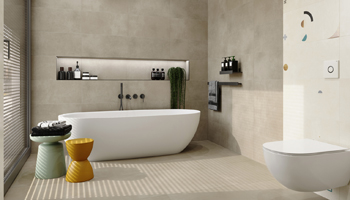Bathroom
 Short-term, but regular, humidity may apply excessive loads to the base structures and, for penetrating humidity, may create ideal conditions for micro-organic growth. Therefore, water leakage to the base must be prevented. To this end, we recommend applying the following procedures and types of construction materials:
Short-term, but regular, humidity may apply excessive loads to the base structures and, for penetrating humidity, may create ideal conditions for micro-organic growth. Therefore, water leakage to the base must be prevented. To this end, we recommend applying the following procedures and types of construction materials:
Type of structure
- PE 201, PE 202 Primer
- SE 1 waterproofing screed
- SE 5 sealing tape with a min. width of 80 mm
- AD 510 PLUS or AD 509 adhesive
- Ceramic tiles
- GF DRY or GF BIO jointing material
- SI silicone sealant + polyethylene separator
Work procedure – detailed description
Preparation: The base must be rigid, cured, and free of any impurities and uneven spots. In the event of any problems in these areas, use LE 21 for levelling of the walls and floors. For quick localized repairs, use MO 35 QUICK.
Priming absorbent bases: All absorbent bases must be primed with PE 201. For extremely absorbent materials, use PE 202 at the required dilution ratio (approx. 1:3-5). Approx. 0.15-0.25 l/m2 of the product is needed.
Insulation – sealing all water-loaded rooms: Insulate the primed surfaces with SE 1 in two layers, taking a 4 – 6 hour break between applications. The tiles will be ready for loading and gluing after approx. 10-12 hours. Approx. 1.2-1.6 kg/m2 is needed. For bridging any transitions and joints, and for reinforcing the internal corners, SE 5 gauze is inserted into the insulating layer. The gauze must be attached across the entire surface of the SE 1. Approx. 0.25 kg/mb is needed for full contact.
Installation of ceramic wall and floor tiles on the insulation layer: Modified adhesive sealants must be used for wall and floor tile installations. For the standard formats within our housing ceramic programme, we use C1TE grade AD 510 PLUS cement adhesive. For smaller formats and mosaics, C1TE grade white AD 509 PLUS cement adhesive may be used. Between 2 and 4 kg/m2 of sealant is needed.
Ceramic shell jointing: For jointing, we use flexible GF BIO material, or CG2 WA grade GF DRY. Thanks to special additives, use of these jointing materials increases the water repellent qualities of the system; GF BIO moreover offers protection against mould and efflorescence. This markedly increases the sanitary properties of the entire surface! Between approx. 0.3 and 0.8 kg/m2 is typically needed, depending on the format size of the tiles.
Sealing of flexible joints and passageways with permanently elastic sealant: Permanently elastic SI sealant must be used to allow expansion movement within the joint. The colour range covers all colours of the GE DRY product line. If SI silicone is applied, it is recommended that a PES polyethylene separator be used. It will prevent undesired adhesion to the bottom of the joint and define the exact shape of the silicone filler. The spreading rate of the 310 ml cartridge is approx. 6-12 mb, depending on the size of the joint.
Cleaning: Use the CL 802 cleaning agent to remove any cement deposits. Once the surface is thoroughly cleaned, we recommend that full-surface priming be applied with CL 809.
Maintenance: Use the CL 804 (tiles, faucets, sanitary installations, etc.) and CL 803 (floors) cleaning agents for regular cleaning.







